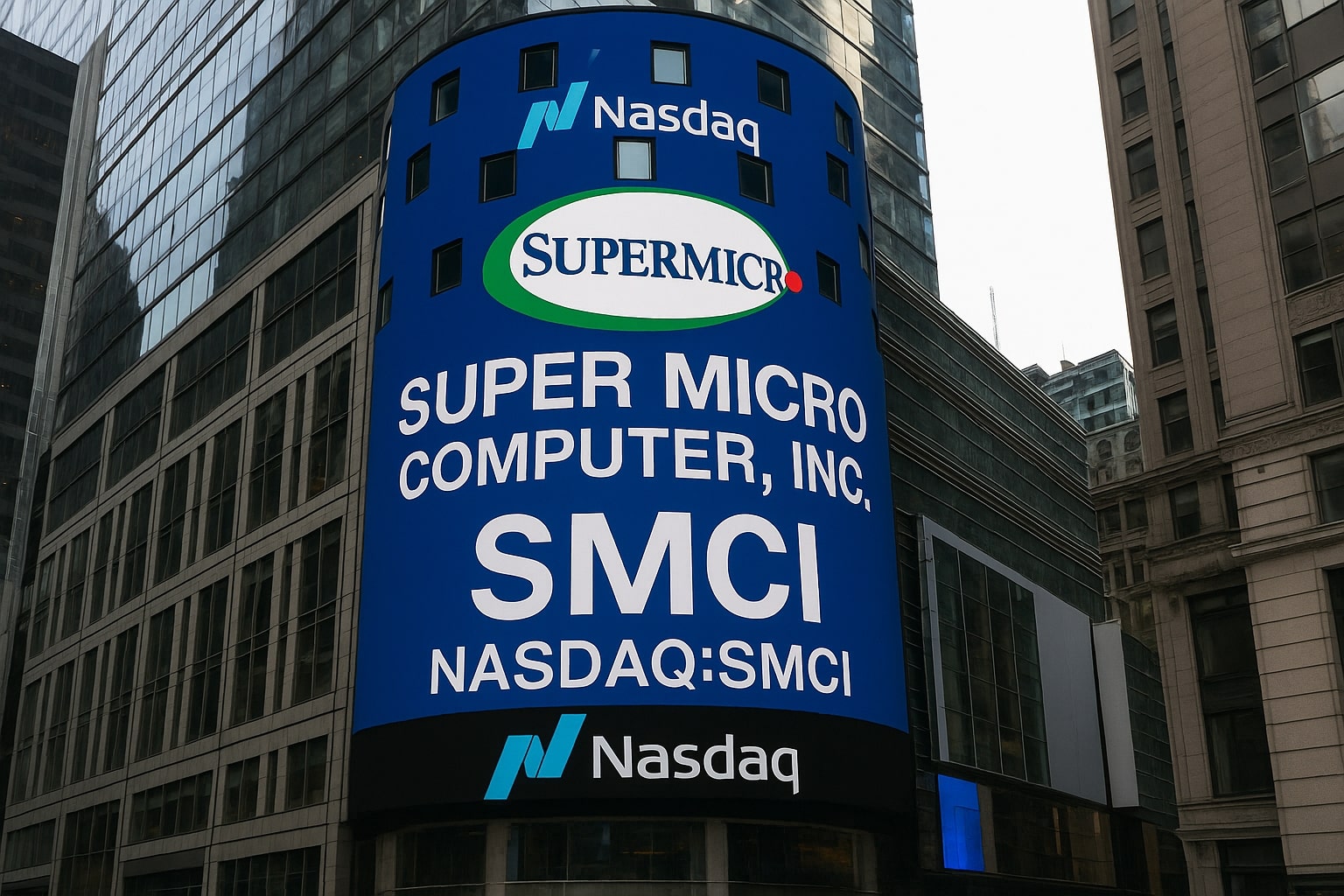
Supermicro (NASDAQ:SMCI) Stock Slumps 20% on Guidance Cut, DCBBS Seen as 2026 Growth Catalyst
SMCI trims outlook to $33B revenue for FY2026, margins fall below 10%, but modular Data Center Building Block Solutions may reset growth trajectory in the back half of FY2026 | That's TradingNEWS
NASDAQ:SMCI Pulls Back 20% as Guidance Cut Resets Market, But Growth Inflection Looms in FY2026
Super Micro Computer Inc. (NASDAQ:SMCI) shocked investors with its fiscal Q4 2025 report, missing both top and bottom-line expectations while issuing one of the weakest near-term outlooks in years. Revenue for the quarter grew just 7.5% year-on-year, well below the 35% growth once anticipated, and non-GAAP EPS guidance for Q1 FY2026 implies a 37% decline. Management slashed its full-year FY2026 revenue projection from $40 billion to “at least” $33 billion, an $7 billion cut that immediately knocked 20% off the stock price, bringing shares back in line with their 5-year average valuation of 17.5x forward earnings. The disappointment highlighted both execution risk and fierce competition in supplying NVIDIA’s next-generation Blackwell systems, where shipment delays and possible share loss dragged results lower. Yet management insists the turning point is not far off, projecting a 50% surge in full-year sales as large-scale GB200 server deployments and modular Data Center Building Block Solutions (DCBBS) accelerate in the back half of FY2026.
Data Center Building Block Solutions Seen as the Margin Driver for NASDAQ:SMCI
The modular rack-scale platform launched in Q4 2025 marks a strategic pivot for SMCI. Designed to compress data center build timelines from 12–18 months down to 3–6 months, DCBBS integrates GPUs, CPUs, storage, networking, and liquid cooling into a pre-configured solution. Management believes this could account for 30% of revenues by Q4 FY2026, or close to $9.9 billion in sales, providing both scale and higher-margin mix compared to hyperscale contracts. Already, Supermicro is seeing traction among enterprises and telcos, which represented 36% of revenue in Q4 2025, down from 42% in Q3, but poised to rebound once DCBBS volumes increase from December 2025 onward. Analysts argue this product line could be the key to reversing three straight quarters of declining gross margins, which slipped to 9.6% in Q4 2025 from levels near 15% a year earlier. Management concedes margins will remain in single digits for Q1 FY2026 but expects gradual improvement as enterprise mix rises.
Balance Sheet Strength and Capital Raise Bolster Expansion
Despite the sharp earnings miss, Super Micro Computer closed FY2025 with $5 billion in cash and equivalents, aided by a $2.265 billion capital raise and $2 billion convertible note issuance in June, priced at a conversion rate of $55.20 per share. A $1.8 billion receivables facility further reinforced liquidity. Debt stood at $4.76 billion, leaving the company with a modest net cash position of $412 million. The raise not only enhances working capital but also ensures flexibility to fund accelerated production as NVIDIA shortens its GPU product cycle, which has forced SMCI into continuous ramp-up mode. Inventories surged 20% sequentially, with days inventory on hand rising to 87 from 74, largely due to delayed customer orders. Management insists inventory levels will normalize once GB200 shipments move at scale in Q2 FY2026.
Geographic Sales Shift and Competitive Dynamics in NASDAQ:SMCI
Revenue mix is undergoing a dramatic reshaping. U.S. sales fell 33% year-on-year in Q4 2025, while Asia climbed 91% and Europe advanced 66%. This shift reflects both rising demand from Asian hyperscalers and competitive pricing pressures in North America. The transition poses risks as reliance on overseas customers rises, but it also offers upside as Asian buyers rapidly scale AI infrastructure. Competitively, SMCI remains a second source provider to NVIDIA (NASDAQ:NVDA), where margins are thinner than traditional enterprise deals, but the firm’s focus on modular platforms aims to reduce this dependency. Analysts point to rivals Dell Technologies (NYSE:DELL) and Hewlett Packard Enterprise (NYSE:HPE), which trade at lower multiples, but argue SMCI’s innovation pipeline justifies a premium. Current valuation at 1.34x price-to-sales places it between those peers and higher-flying AI hardware plays, offering potential rerating if execution improves.
Valuation, Outlook, and the Road Toward FY2026 Inflection
Following the reset, NASDAQ:SMCI trades at 17.5x forward non-GAAP P/E, 20% above the 14.6x level before earnings but still below AI infrastructure peers that command richer valuations. Guidance implies roughly $6.5 billion in Q1 FY2026 revenue, representing only 9.4% growth year-on-year, but a ramp to $9 billion quarterly sales through the rest of the fiscal year. If achieved, this trajectory translates to 50% full-year growth, a sharp rebound from the muted 7.5% posted in Q4 FY2025. Execution remains the swing factor: delays, macro weakness in AI spending, or inventory write-downs could derail the path, but catalysts in GB200 deployments and DCBBS adoption offer a realistic route to recovery.
Verdict: Hold — With Selective Buy-on-Dip Potential
At $681.40 per share post-selloff, NASDAQ:SMCI is trading at 17.5x forward non-GAAP P/E, in line with its historical 5-year average but below high-growth AI hardware peers that sit at 25–30x. Near-term execution risk is real: Q1 FY2026 guidance implies only 9.4% revenue growth, margins are stuck below 10%, and U.S. hyperscaler softness is weighing on mix. The stock deserves a Hold call until evidence emerges that Data Center Building Block Solutions (DCBBS) ramps to the projected $9–10B revenue run-rate by late FY2026 and margins rebound toward 12–13%.
That said, the 20% correction already prices in the weak near-term outlook, and for long-term AI infrastructure investors, selective accumulation below $650 offers asymmetric upside. If NVIDIA GB200 deployment schedules normalize and SMCI executes on DCBBS, FY2026 revenue could still approach $50B, justifying a re-rating closer to 22–24x forward earnings, which would put the stock back in the $850–$900 range.
So for traders: Hold, wait for stabilization. For patient AI-focused investors: accumulate dips into the $620–$650 range with an eye on FY2026 as the inflection point.
That's TradingNEWS
Read More
-
PPA ETF at $154: Can This Defense ETF Keep Beating ITA and SPY?
14.12.2025 · TradingNEWS ArchiveStocks
-
XRP ETFs XRPI and XRPR Pull In $975M While XRP-USD Fights To Hold $2
14.12.2025 · TradingNEWS ArchiveCrypto
-
Natural Gas Price Forecast: NG=F Hits $4.11 As Warm Winter Outlook Puts $3.913 Support At Risk
14.12.2025 · TradingNEWS ArchiveCommodities
-
USD/JPY Price Forecast - Dollar to Yen Can BoJ’s 0.75% Shock Break The 155–158 Range?
14.12.2025 · TradingNEWS ArchiveForex


















